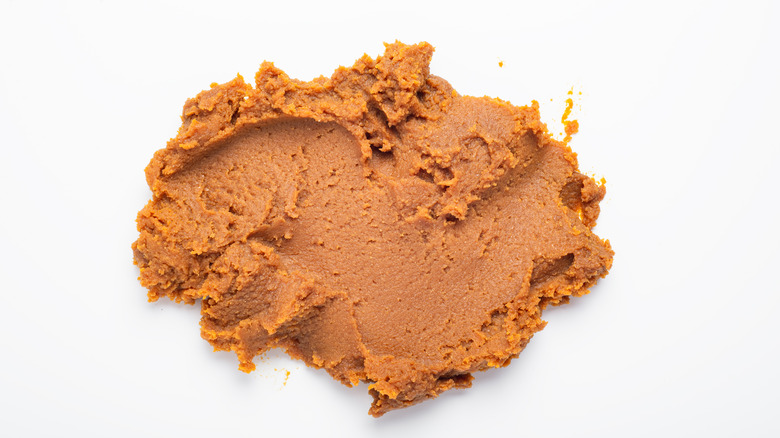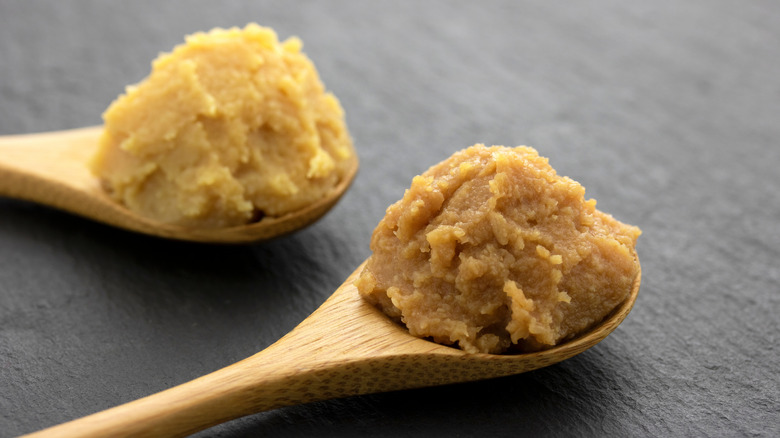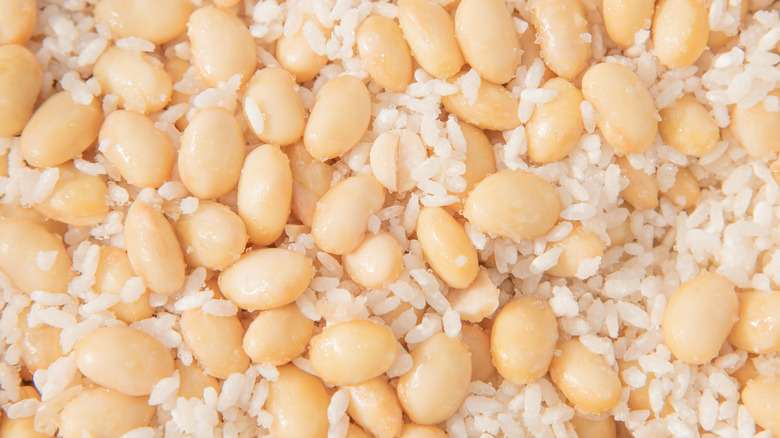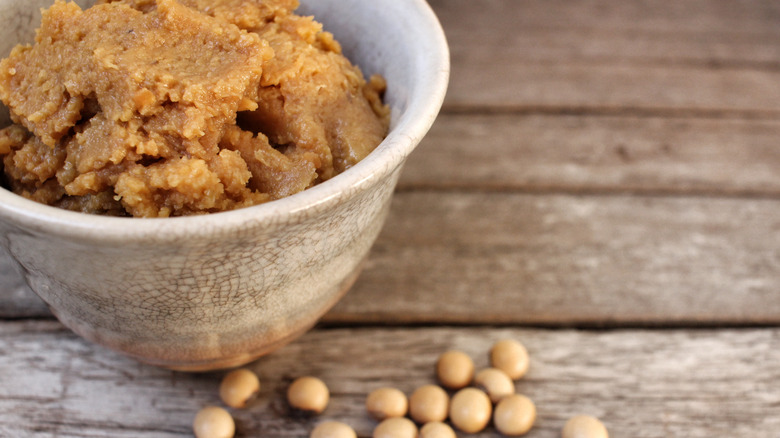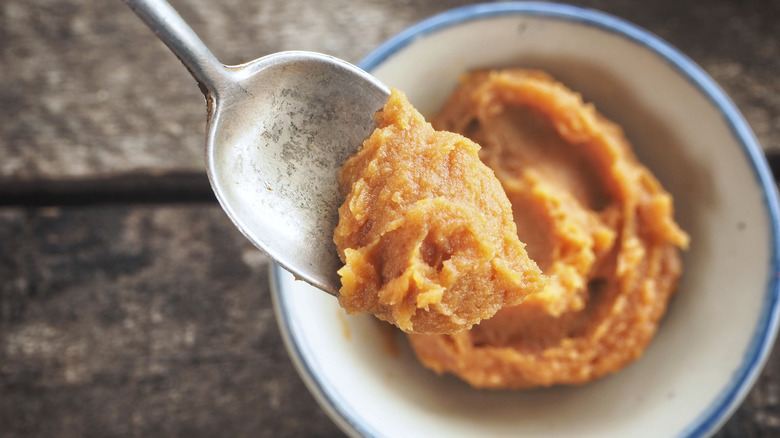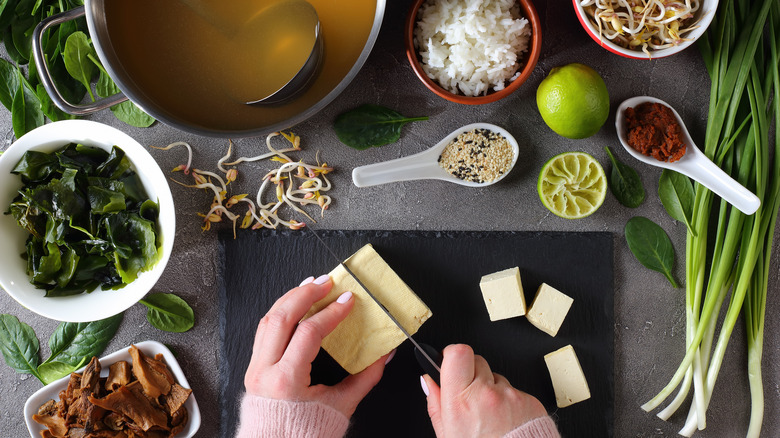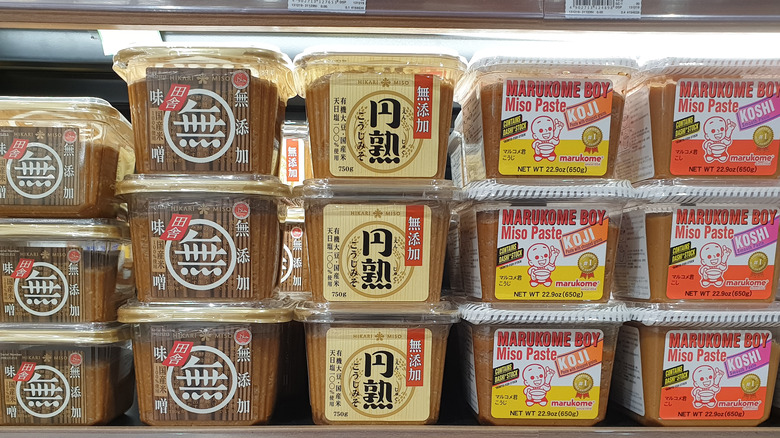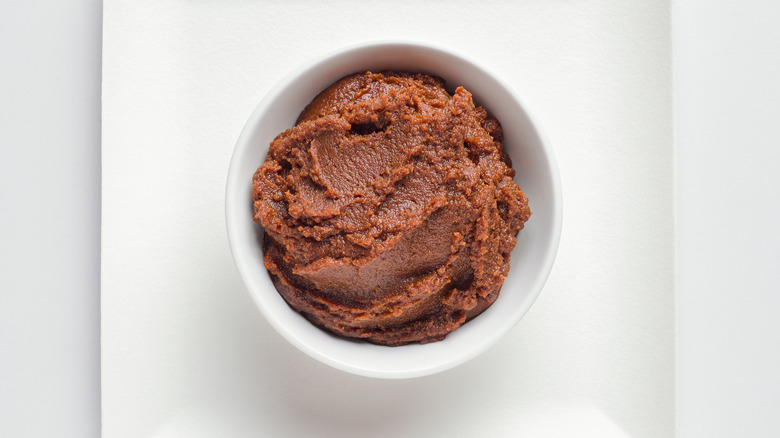What Is Miso And What Does It Taste Like?
If you love the taste of miso in your food but are not sure where to begin with it in your own cooking, it might be helpful to develop a more complete understanding of the complex ingredient. While you might remember the discussion of miso as a form of salt in chef Samin Nosrat's "Salt Fat Acid Heat" series on Netflix, the traditional Japanese ingredient has a rich history and many forms it can take, which requires a deeper dive into the food. In fact, there was an entire governmental body set up in Japan to regulate miso in 701 A.D. by Emperor Mommu, according to Bon Appétit.
Today, there are three main flavors of miso available, in addition to tons of less traditional variations made with other base ingredients before the fermentation process happens. No matter what kind of miso you choose to work with, you'll ultimately end up with an ingredient that adds an earthy, tangy depth of flavor among other notes to whatever you're making.
What exactly is miso?
The base of miso is transformed into the fermented paste we all know and love thanks to the addition of koji, a mold known scientifically as Aspergillus oryzae (via Bon Appétit). Koji can be made from rice, barley, or soybeans. The most common type of miso sold in the United States, kome-miso, is made with a base of soybeans and rice koji. Other types of miso are made with soybeans alone (known as mame-miso) or soybeans with barley (mugi-miso).
There are also miso varieties that use different kinds of bases such as lima beans, chickpeas, or farro, among other ingredients. According to Perma Culture Research Institute, miso can even be made with lentils.
The amount of time that the base ingredient, the koji, and salt ferment together determines the flavor of the miso. Those that are aged for a short period of time tend to be sweeter and have a milder flavor, while those that age for longer periods — even years — have a very strong flavor and tend to be quite salty.
How is miso made?
Generally, miso is made by mixing cooked, mashed soybeans with koji and salt. Depending on the desired consistency, the soybean mixture will be mashed into a chunky or completely smooth paste. The more koji that is used, the sweeter the miso will be. The mixture is typically rolled into large, palm-sized balls that are then placed inside a fermentation vessel or pot. The balls of soybean and koji are pressed firmly so that no air pockets are present in the fermentation pot, which could allow mold to grow rather than ferment. (That's also why the mixture is topped with a layer of salt before it is set away to age.)
Once the ingredients are combined, the enzymes in the koji start the fermentation process, which develops in what we know as miso. Depending on the type, desired flavor, and quality of the miso, the ingredients are often aged for weeks to months or even years to get the desired result, says The Spruce Eats.
The difference between white, yellow, and red miso
According to The Spruce Eats, there are more than 1,000 types of miso. However, the three primary colors available (generally white, red, and yellow) indicate different flavor profiles (and each one may come in a smooth or chunky texture). Shiro, or white miso, is the mildest of the three and typically has a sweet flavor. Shinshu, or yellow miso, is the next most flavorful of the three colors and tends to be more versatile. Finally, aka (red miso) is the strongest of the three because it is fermented for the longest period of time and has a distinctly salty flavor.
Those that are not used to miso should likely start with one of the milder options (white or yellow) before jumping right into the strongest flavor (red). If you don't want a sweet flavor for whatever you are making, opt for the yellow version, which has a more balanced yet salty and earthy flavor without being too overwhelming.
What does miso taste like?
Master Class describes miso paste as having a "toasty, funky, salty-sweet richness." However, it's miso's umami flavor that is largely savory and tends to be a central flavor for many Japanese dishes where miso shines. The paste is usually described as being earthy too. It's worth considering other fermented foods to get an idea of what miso tastes like. Things like plain yogurt, kombucha, and kimchi are all fermented and all have a particular tangy sourness or tartness that you can also expect from miso on a deeper, saltier level. Miso can, of course, have a sweeter flavor if it is younger.
If you are new to miso and do not know where to start, it's best to begin with a milder miso and work your way to the darker, more flavorful pastes. Choose a white miso for sweet dishes or a yellow miso for savory recipes. If you really love the flavor, slowly work your way through darker colors of miso to build up your affinity for the distinct flavor.
How to cook with miso
Many people are most commonly familiar with miso as it relates to miso soup. However, the trendy ingredient is quickly becoming a go-to means for adding depth of flavor to new recipes and even dressing up classic dishes. According to Bon Appétit, you can use miso for so many options, such as adding it to pesto and even peanut butter and jelly sandwiches, to coating vegetables or making salad dressings with unforgettable flavor.
As explained above, the darker the color of the miso, the stronger the flavor will be, which should alter the way in which you should cook with it. Sweet, mild miso is great for baking while red miso is far better in dishes that cook for longer periods of time, so it can really permeate the meal and mingle with the other flavors. One popular way to use miso is to mix it into butter to make a compound ingredient that can then be mixed into dishes that are both savory (like pasta or mashed potatoes) and sweet, such as cakes and cookies.
Where to buy miso
While there are seemingly endless miso options available in Japan, there are fewer options in the United States, according to The Spruce Eats. However, you can easily find at least one option at most grocery stores. Many of the big chains will have at least some kind of miso in a plastic tube or tub.
For more specific types of miso, you should try visiting an Asian market like H Mart, a health food store, or searching online. In so doing, you'll find a wider range of options and shades of miso packed in small tubes or jars to even larger tubs if you need more quantity. Depending on the shop or vendor, you can likely find various alternative bases to the soybean mainstay options as well.
So if you want to try another version of your favorite miso, or if you're allergic to soy and need a different base, such as lima bean, these specialty outlets are the best place to look.
Nutritional information about miso
According to Very Well Fit, the USDA claims that 17 grams of miso paste, which is about one tablespoon, has 33.7 calories, 1 gram of fat, 4.3 grams of carbs, and 1 gram of fiber. It also packs in 1.1 grams of sugar, 2.2 grams of protein, and 634 milligrams of sodium. While some claim that miso is a great source of vitamins and minerals like B and K vitamins, copper, and more, the USDA claims that a 1 tablespoon serving is not enough to get a significant amount of these nutrients. Since miso is high in sodium, it's also good to ensure you don't use too much of the paste in your cooking or over-salt the dish.
Miso paste does have some health benefits, too. Very Well Fit notes that some people may have a positive reaction to soy products like miso to improve their glycemic response. In moderation, miso is also a great alternative to salt because it does not raise blood pressure or cholesterol like salt might. Finally, it might even help with inflammation.
